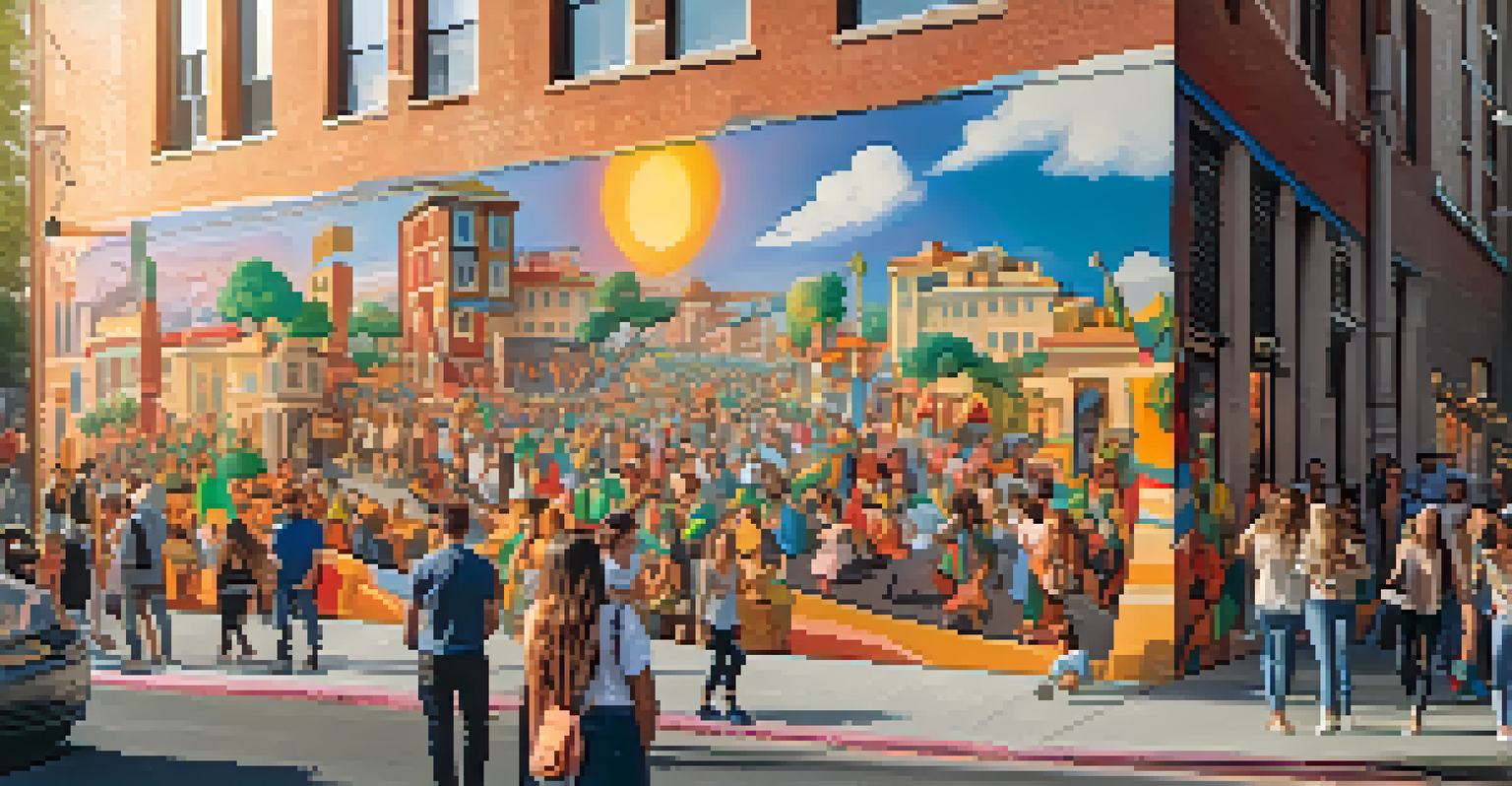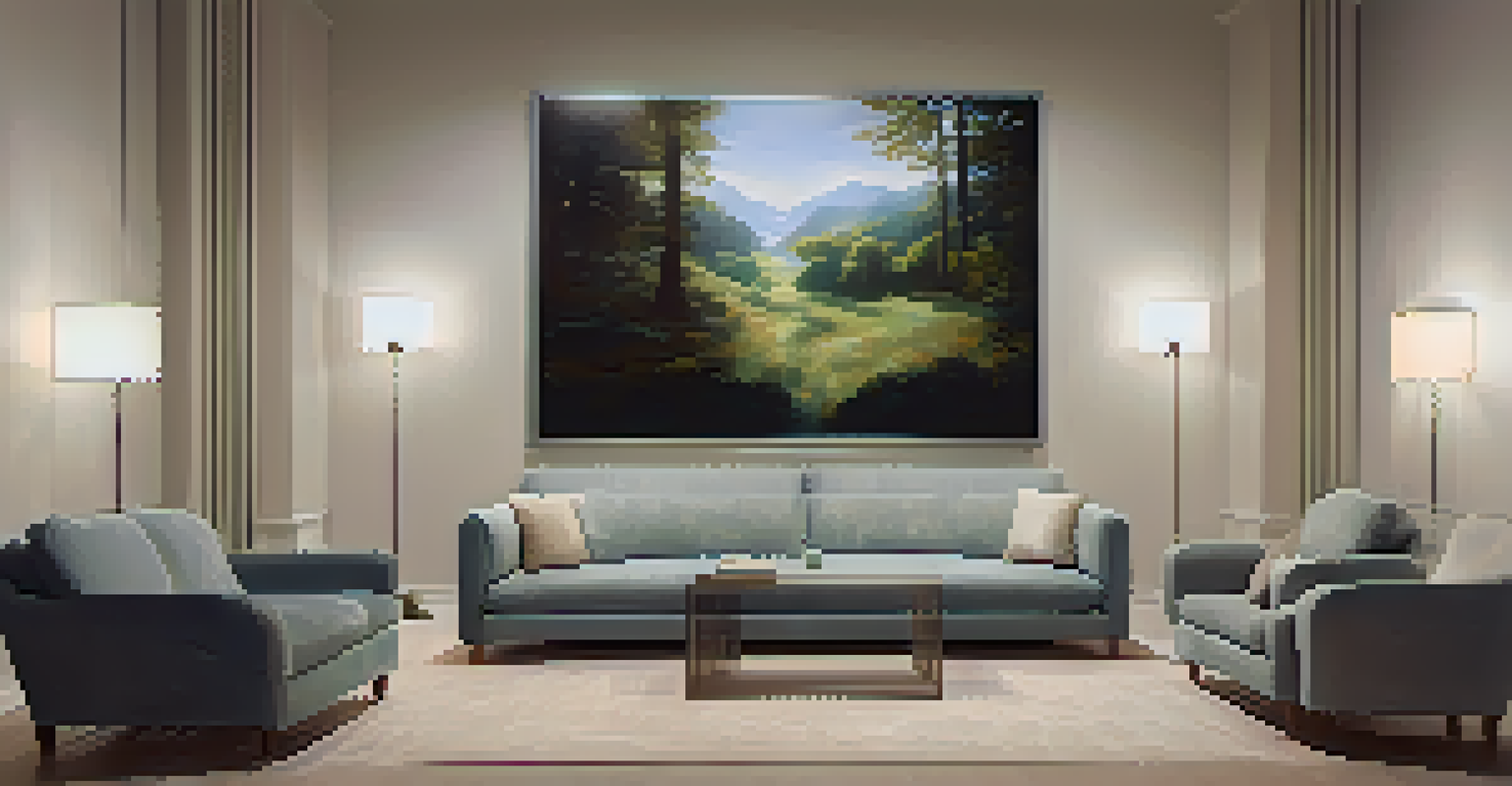Augmented Reality in Art: Bridging Real and Digital Worlds

Understanding Augmented Reality (AR) in Art
Augmented Reality, or AR, overlays digital elements onto the real world, creating an interactive experience. In the realm of art, this technology allows artists to enhance their creations by adding layers of information, animations, or even sound. Imagine walking through a gallery and pointing your phone at a painting, only to see it come to life with movement and sound—a captivating way to engage with art.
Augmented Reality is not just a new technology; it is a new canvas for artists to explore and express their creativity.
This fusion of the physical and digital worlds opens up numerous possibilities for artists. They can create immersive installations that invite viewers to interact with their work, breaking traditional boundaries. For instance, an artist might display a static sculpture that reveals hidden stories through an AR app, enriching the viewer's understanding.
Additionally, AR can make art more accessible to a broader audience. By simply using a smartphone or tablet, anyone can experience enhanced artworks, regardless of their location. This democratization of art allows for a more inclusive appreciation of creativity.
The Role of Technology in Artistic Expression
Technology has always influenced art, but AR takes this relationship to a new level. Artists can experiment with digital tools to create pieces that would be impossible without technology. For example, a digital painting can morph based on a viewer's movements, making each interaction unique and personal.

Through AR, artists are not just creating static images or sculptures; they're designing experiences. This shift encourages creators to think outside traditional mediums, fostering innovation. A mural may not just be a visual feast but also a narrative journey that unfolds as viewers engage with it through their devices.
AR Enhances Art Engagement
Augmented Reality creates interactive experiences that deepen emotional connections between viewers and artworks.
Moreover, the integration of AR in art challenges conventional notions of ownership and authenticity. Digital art can be shared and experienced by many, raising questions about what it means to own an artwork. This new frontier invites discussions about the value of art in the digital age.
Immersive Experiences: A New Way to Engage with Art
One of the most exciting aspects of AR in art is its ability to create immersive experiences. Imagine stepping into a gallery where every piece of art transforms into an interactive spectacle as you approach. This kind of engagement not only captivates the audience but also encourages deeper emotional connections with the artwork.
Art is a way of survival, and with AR, we are creating new paths for artistic expression that resonate with audiences beyond traditional boundaries.
For instance, exhibitions like the Museum of Modern Art's 'The Night Café' used AR to allow visitors to step inside Vincent van Gogh's iconic painting. Participants could explore the environment, making the experience feel personal and adventurous. Such initiatives illustrate how AR can redefine how we interact with historical art.
Additionally, immersive experiences can extend beyond galleries. Street art, for example, can utilize AR to provide viewers with a richer narrative about the artist or the artwork itself. This dynamic interaction can transform public art into a living, breathing entity that engages communities in new ways.
Case Studies: Successful AR Art Projects
Several projects have successfully showcased the potential of AR in the art world. One notable example is the 'AR Museum' app, which allows users to view famous artworks in their own spaces. By simply pointing their device at a wall, users can experience iconic pieces from renowned artists, bridging the gap between home and museum.
Another fascinating project is 'The Ice Age: Art and Culture' exhibition, where AR brought ancient cave paintings to life. Viewers could scan the artworks to view the scenes depicted in motion, providing context and a deeper appreciation for these historical treasures. Such case studies illustrate how AR can enrich our understanding of art across different eras.
Technology Fuels Artistic Innovation
The integration of AR allows artists to explore new forms of expression, transforming static pieces into dynamic experiences.
These examples highlight how artists and institutions are embracing technology to engage audiences in innovative ways. By leveraging AR, they create memorable experiences that resonate long after the viewer leaves the gallery.
Challenges Facing AR in the Art Scene
Despite its exciting potential, integrating AR into the art world isn't without challenges. One significant issue is the need for advanced technology, which can create barriers for both artists and audiences. Not everyone has access to the latest devices or the internet, limiting who can fully engage with AR experiences.
Furthermore, there’s the concern of over-saturation. As more artists adopt AR, distinguishing unique projects from the noise can become difficult. This abundance of content may lead to viewer fatigue, where audiences become desensitized to the novelty of AR-enhanced art.
Additionally, artists must navigate copyright issues related to digital content. Since AR often involves layers of digital information, understanding how to protect their work while allowing for creative expression can be a complex challenge.
The Future of AR in the Art World
Looking ahead, the future of AR in art appears promising, with ongoing advancements in technology paving the way for new possibilities. As AR becomes more mainstream, we may see even more innovative applications that redefine how we experience art. Imagine virtual galleries that anyone can access from anywhere in the world, showcasing the work of diverse artists.
Moreover, as artists become more familiar with AR tools, we can expect a surge in creativity. The combination of art and technology will likely lead to new genres and forms of expression that we can only begin to imagine today. This evolution is poised to inspire a new generation of artists and art lovers alike.
Challenges of AR Adoption
Despite its benefits, AR faces challenges such as technology accessibility and copyright concerns that artists must navigate.
In this way, AR not only enhances our appreciation for existing art but also cultivates a vibrant, evolving art culture that embraces innovation. As we continue this journey, the dialogue between the real and digital worlds will only deepen, ultimately enriching our collective artistic experience.
Conclusion: Merging Realities for Artistic Innovation
In conclusion, Augmented Reality is revolutionizing the art world by merging the physical and digital realms. This technology not only enhances the viewer's experience but also challenges artists to rethink their creative processes. By engaging audiences in new and exciting ways, AR is transforming how we perceive and connect with art.
As we embrace these changes, it's essential to recognize the potential for AR to democratize art, making it more accessible to diverse audiences. The fusion of technology and creativity encourages a more inclusive dialogue about art's role in our lives, bridging gaps between cultures and communities.

Ultimately, the journey of AR in art is just beginning. As artists and institutions continue to explore this innovative medium, we can look forward to a future where art transcends boundaries, inviting us all to engage in a vibrant, shared experience.